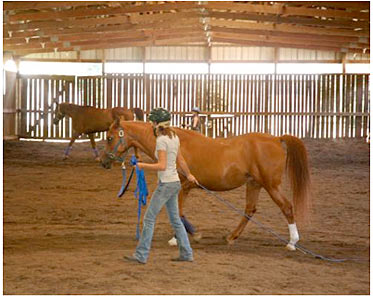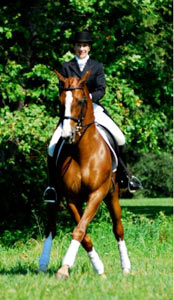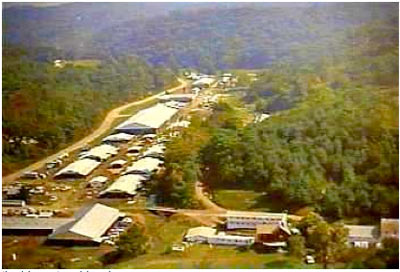 |
 |
|
Using Pressures to Shape the Horse
Training horses involves using pressures to shape a horse's behavior. But many people misunderstand how to use pressures properly.
by Ron Meredith, Meredith Manor International Equestrian Centre
Horses will learn when:
•a pressure is not perceived as an attack,
•the pressure is only one step away from something the horse already understands, and
•if doing the correct thing relieves the pressure which rewards the horse.
When all three of these things are in place, then the pressure will be "horse logical." The horse will accept it calmly and learn from it.
Many trainers attack horses.
They think that if the horse's activity level or excitement level increases, the horse is learning more.
That's one of the biggest misunderstandings there is in the training world. In fact, the truth is just the opposite.
When a horse feels attacked, you have created an avoidance situation. Avoidance situations create
five times as strong a reaction as approach situations. That means that if you create a pressure that
the horse wants to avoid, you create five times as much negative feeling as you do if you use an approach situation instead. What does that teach a horse?
When most people come to the end of their knowledge of how to enforce training positively, they often resort to avoidance pressures. Yank that lead shank. Pop him with the end of the rope. Jab
him with those spurs. Those actions all create a high level of activity in the horse because the horse
feels he's being attacked by a predator. Do you want that horse to react to you like a prey animal or a partner?
Have you ever noticed how people talk to someone who doesn't speak English well? The first thing
you know, they're talking louder. The problem isn't that the other person can't hear. It's that they
don't understand the language. So you cannot be louder with your aids or pressures to achieve the desired result with your horse.
Many people don't know how to link the things a horse needs to learn up in a logical sequence or
how to break training down into many small building blocks the horse can learn one by one. They put pressure on the horse to do something, to create a particular shape, before the horse
understands all the baby steps he needs to get him to the point of understanding. Then when the horse doesn't "get it," they "swear" at him.
Swear pressures elevate a horse's excitement levels.
What are swear pressures? Whenever anyone runs out of language, they swear. It's a cheap shot
out of nowhere. But a person with a command of the language can make a number of meaningful points without ever swearing. Swear pressures do not make your point. The only thing they do is
disrupt communications.
To communicate with the horse, you must make the shape you want understandable. You need to
use the right language. You will see a lot of people slap a horse when they want it to move or go
faster. As a training pressure, a slap has a definite "start" but the "stop" is right there with it, too. So
what does the slap tell the horse to do? There is no way for a slap to do anything but elevate the
horse's excitement level. The horse will not be going the specific amount faster you wanted or moving in exactly the way that you wanted.
 How quickly you apply a pressure, where you apply it and how hard you hold it tells the horse how he needs to respond. And as
soon as he responds, you reward by taking the pressure away. The greatest reward to a horse is the release of pressure. Always. So you apply pressure in a horse
logical way that causes the horse to act the way you want, and then you release the pressure as a reward. Then you do it again until the horse's response to that pressure becomes a habit. How quickly you apply a pressure, where you apply it and how hard you hold it tells the horse how he needs to respond. And as
soon as he responds, you reward by taking the pressure away. The greatest reward to a horse is the release of pressure. Always. So you apply pressure in a horse
logical way that causes the horse to act the way you want, and then you release the pressure as a reward. Then you do it again until the horse's response to that pressure becomes a habit.
Some horses will tend to lean into your pressures when you apply them and in order to create an understandable shape at that time, you must keep the pressure there until the horse moves in
relation to it. For example, if you are on the ground trying to get a horse that is leaning into your
pressure to move away from you, you have to push only the amount that you can comfortably hold
until the horse gets tired of it. If the pressure of the flat of your hand or the front of your knuckles
doesn't have any effect, use the butt end of a whip or poke with a finger or two to concentrate the
pressure on a smaller area and make it more noticeable. If you take the pressure away before the
horse gets tired of it, the horse learns that all it has to do is wait and you'll quit. You hold the
pressure until the horse decides to move away from it. And you have to be certain that you don't
get impatient and smack the horse in the belly and ruin everything it was understanding up to that point. Give the horse time to learn. Then reward it.
The timing of a pressure can be important to learning. Take this statement: "Woman without her
man is lost." Now change the punctuation. "Woman. Without her, man is lost." The words are the same but the way they are timed creates an entirely different meaning . Aids are the same way to the
horse. It's the timing, the punctuation, of our aid pressures that often counts, not the strength or force of them. . Aids are the same way to the
horse. It's the timing, the punctuation, of our aid pressures that often counts, not the strength or force of them.
Aid pressures must be balanced in order to create a training corridor for the horse to move in. A horse has a one track mind. Anything will
distract him and when it does, he's gone. He's out to lunch. You see people distracting their horse with badly applied aid pressures all the
time. They only use one aid or pressure too loudly out of all the aids it takes to communicate an understandable shape to the horse. That
distracts the horse from all the other aids that could give him a clue about what to do and he misses the meaning of the communication. Bits are the biggest problem here.
When you communicate horse logically using methodically applied directional pressures that shape rather than attack the horse, you are
training, not breaking. Punishment has no place in a training program. When a horse does something "wrong," that happened because you taught the horse to do it or you
allowed the horse to do it. Punish yourself, not the horse.
Meredith Manor International Equestrian Centre
 |
Meredith Manor is an equestrian career college dedicated entirely to producing professional riders,
trainers, instructors, and farriers for the horse industry. All programs and courses are designed
specifically to prepare you for a successful equine career. Our programs range in length from 3 to 18 months, and our students spend 6 hours a day in primarily hands-on, skill based classes with
additional time spent in the barns and with the horses. Students don't have to excel in academic,
classroom based classes to be successful in our programs, but they must have a passion for horses and a dedication to having a successful equestrian career.
Meredith Manor's name and reputation are known by serious horse people throughout the world. Students from the ages of seventeen to sixty-three have attended the School from every state and
many foreign countries. Meredith Manor strives to provide a climate of learning in which each student may identify and accomplish his or her goals. We have continuously researched the horse
industry, designed the facilities, and developed the educational programs that will give our students
the training, experience, and confidence needed to have successful, life-long careers with horses!
Ron Meredith has over forty years' experience as president of the school and has developed it
from its humble beginnings of six students in 1963 to its current world class level. Because of his
outstanding contributions to the horse industry and specifically to equestrian education, he has received a number of distinctive recognitions including an Honorary Doctorate of Equestrian
Studies. Dr. Meredith has held seven AHSA judges' cards and has trained top level horses and riders in the cutting and reining world.
Meredith Manor International Equestrian Centre
147 Saddle Lane
Waverly, West Virginia 26184
Phone: 800-679-2603
Email: info@meredithmanor.edu
Website: meredithmanor.edu |
 |
|
To advertise your horse product or service, contact Ann
|
 |
|
InfoHorse.com, Horse Information Lives Here ® 12/26/2025
Contact Us to Advertise to over a million Horse Owners.
All images and content Copyright© 2012 by InfoHorse.com, Equusite.com.
Horse Owners are Dog Owners; Dog Product Information dognowner.com
|
|
|
Articles, Academic Schools, Arena Maintenance, Animal Communicators, Barns, Barn and Accessories, Barn Equipment and Tractors, Breast Collars, Grooming Products for Horses, Hay Feeders, Horse Blankets, Horse Books, Horse Videos, Horse Breeders, Horse Camping Gear, Career Schools, Carts and Buggies, Horse Training Clinicians, Equestrian Clothing, Dogs and Puppies, Horse Fencing, Western Art & Furniture, Horse Property for Sale, Horse Products For Sale, Fly Control, Foal Care, Horse Footings, Horse Gifts, Horse Health and Nutrition, Hoof and Leg, Horse Insurance, John Lyons Certified Trainers, Equine Lawyers, Leather Care, Links, Horse Property, Horse Photography, Portable Horse Stalls, Arenas and Roundpens, Horse Riding Schools, Horse Schools, Safety Products, Services for Horses, Horse Trailers, Horse Shipping, Horse Skin Coat Care, Horse Software, Specialty Trainers, Horse Summer Camps, Tack, Horse Trainers, Treats and Snacks, Truck Accessories, Trucks, Horse Vacations, Western Lifestyle, jewelry
|
|
|
|